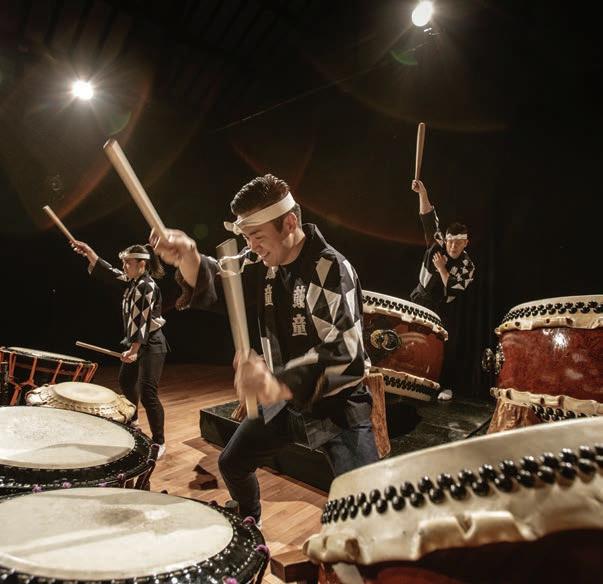
6 minute read
Hit your mark with online advertising
303-566-4100
Once implemented, every building in Denver will be required to provide three waste bins: land ll, recycling and compost. is includes restaurants, businesses, o ces, stadiums and multi-family housing with more than four units. With greater access to recycling and composting, the people of Denver will have the opportunity to appropriately sort their trash.
Another important component of the policy requires construction and demolition sites to adopt more sustainable practices.
“Demolition waste accounts for half of our climate emissions and materials like metal, corrugate, glass, concrete and asphalt can be diverted from the land ll,” Tafoya said, adding that the Waste No More law will ensure these materials are properly recycled.
Timeline is di erent than other ballot measures
Waste No More will be enforced by the city of Denver with the O ce of Climate Action, Sustainability and Resiliency taking the lead. But there is a lot of uncertainty about how the new law will work and it could be awhile before it is enforced.
Since Waste No More was a citizen-led initiative, the timeline for enforcement looks a little di erent than other ballot measures written by city council. One cause for delay can be attributed to the language the initiative used because it is not what the city would use.
Grace Rink, Denver’s chief climate o cer, used a tra c violation as an example. When a person gets a trafc ticket, there are speci c guidelines for how to appeal that ticket. With Waste No More, how it will be enforced is not written into the language, Rink said. Additionally, Rink added, the way it is currently written implies that an apartment building can be ned for not complying, but it does not de ne what the ne is or what an appeal looks like. erefore, Rink said, the bill must be revised, but the language on the original ballot cannot be changed for at least six months after the election. ere are a few steps the city is doing in the meantime to get things rolling. First, a task force must be created. is group of 25 individuals will consist of stakeholders from entities that are regulated by the ordinance. ese include recycling centers, trash haulers, special events companies, restaurant owners, organics processors and building owners. Waste No More ballot sponsors will hold two seats, according to Tafoya. Rink said the task force will hold regular meetings for six months, beginning in March and the public may attend and observe. e goal of this task force is not to rewrite the ordinance, but to make recommendations for adjustments to state concise rules and enforcement guidelines. ese regulation revisions must rst be approved by city sta and then presented to city council.
Ordinances working in tandem

In addition to Waste No More, other environmentally-focused proposals were recently adopted in Denver. ese include the “pay as you throw” trash pickup, which charges for land ll waste bins while recycling and compost are free; the Bring Your Own Bag program, which encourages reusable bag use by charging for disposable bags; and the Single-Use Accessory Restriction Ordinance which requires all retail food establishments to only provide single-use condiments and plasticware upon customer request.
A statewide Producer Responsibility Ordinance (PRO) was also signed last summer. e PRO will provide free and equitable recycling to all Coloradoans as well as encourage more sustainable practices from Colorado manufacturers.
All of these ordinances will work in tandem to accelerate Denver’s goal. “CASR, in partnership with Denver’s Department of Transportation & Infrastructure and the Denver Department of Public Health & Environment, recommends to divert 50% of all solid waste generated by 2027 and 70% by 2032,” according to devergov.org.
With regard to Waste No More speci cally, some businesses have already adopted the three waste stream practices.
Vital Root, a restaurant located at 3915 Tennyson St. in Denver’s Berkeley neighborhood, has been o ering three waste streams for years. e restaurant has incorporated the use of compostable supplies, including takeaway containers.
One of the managers, Kathryn Begley, said it’s important to the company and the restaurant’s guests to be environmentally conscious.
“It is a big mission statement to us,” said Begley.
But the city needs to provide better education on how to sort waste material, Begley added.
Customers are receptive to the recycling and compost program at Vital Root, but Begley has noticed there are issues with people knowing what is compostable and what is not.
“Lots of people will send their whole trays to the trash, even though we have made an e ort to provide recycle and compostable bins,” Begley said. “ e general public needs better education.” e city is preparing to improve the education program to help residents learn how to properly dispose of their trash. Clear messaging in multiple languages, as well as the use of symbols, are part of these improvements.
Vital Root isn’t the only business struggling with material sorted by the public becoming contaminated. A1 Organics processes all the composting in Denver and has reported seeing glass mixed in with composted materials, Rink said. Unfortunately, this contaminates the material that can be composted so all of it has to be taken to the land ll. To combat this, A1 has restricted the material it will accept to just the basics: food scraps and yard waste only.
“Right now, everywhere you go the recycling signs are di erent,” Rink said. “It only adds to the confusion.” Rink’s goal is to provide the same information citywide. Whether it’s at school, a restaurant or at home, the same trash/recycling/compost signage will be posted throughout Denver.
“Education is key,” Rink said. “It’s one thing to o er the three waste streams, but if we are not using it right, it defeats the purpose.”
Ensemble to display their skill at University of Denver





BY CHANCY J. GATLIN-ANDERSON SPECIAL TO COLORADO COMMUNITY MEDIA


O the west coast of Japan lies the island of Sado, home to luscious green forests, steep oceanside cli s and the most renowned taiko drummers in the world.
Early mornings on the island, residents are greeted with the deep, thumping sound of drumming as they make their way to work and school. e radiating sound of a gong can be heard for miles as the performers practice throughout the day to perfect their ancient craft. e drumming of the KODO ough the ensemble performs with various instruments during its shows, the taiko are at the forefront of a Kodo performance. Taiko drums were introduced to Japan in the sixth century CE through Korean and Chinese cultural in uence along the Silk Road, a panEurasian trade system that lasted for nearly two millennia. Contemporarily used as traditional performance instruments, taiko have been used throughout Japanese history — during wartimes to organize troops, at royal processions, throughout religious rituals and sometimes as personal instruments. Performance taiko drumming evolved in the mid-20th century, becoming popular at Japanese festivals to entertain laypeople. Later in the 1980s, taiko performance would become popularized worldwide with traveling ensembles like Kodo. e Kodo Taiko Performing Arts Ensemble will be performing at the Robert and Judi Newman Center for the Performing Arts at the University of Denver on Feb. 18 and 19. Kodo will perform its One Earth Tour entitled “Tsuzumi.” e performance will be a highlight of Kodo’s home on Sado Island, sharing the tale of its ancient history and tranquil landscape.
Taiko Performing Arts Ensemble has been the soundtrack to the lives many Sado people as they go about their days for more than four decades.
Sado Island is home to the Kodo Apprentice Center, the home for new hopefuls to complete a two-year apprenticeship program before becoming members of the o cial ensemble. Kodo apprentices live communally at the center, where they learn taiko, dance, song, bamboo ute and other traditional Japanese arts. ey live a very minimalist lifestyle, rid of distractions so they can concentrate on their rigorous training. Cell phones, computers and dating are strictly prohibited for apprentices while living on Sado.












“Kodo One Earth Tour: Tsuzumi is the rst production in a series of commemorative works we created for Kodo’s 40th anniversary celebrations in 2021,” said Director Yuichiro Funabashi in a news release. “ e theme of this work is our home base, Sado Island. With its lush nature and distinct history, this special place has been the starting point for Kodo’s diverse local and international activities for the past four decades. Conjured and honed on Sado, Kodo’s sound is like no other. I sincerely hope you’ll enjoy this performance and the visceral sound of Kodo’s taiko.”








